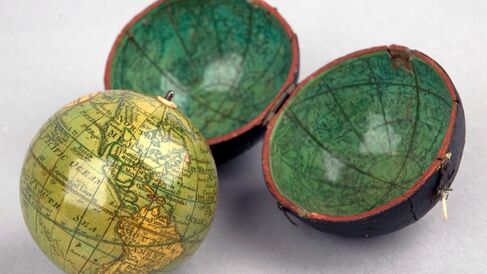Pocket-sized Globes

Pocket-sized globes, measuring around 3 inches in diameter, had several functions including acting as status symbols for gentlemen and educational tools for children. Although the popularity of pocket globes peaked in the first half of the 18th century, makers continued to produce the items into the 19th century.
The 'English Globe' is a rare example of an immobile globe, whose sphere does not rotate but is fixed in place over a planisphere. Its fixed position allows complex calculations to be performed more easily than with a turning sphere.
Roger Palmer(1634-1705), Earl of Castlemaine and Cambridge-educated son of Sir James Palmer, collaborated with Joseph Moxon (1627-1691), son and apprentice of printer James Moxon, in 1679 to produce an instrument that they named the 'English Globe'. Three examples of English Globes are preserved at the University of Cambridge in the University Library, Pembroke College, and the Whipple Museum (on loan from Trinity College, Cambridge).
Joseph Moxon brought pocket globes to England between 1659 and 1670. Pocket globes consist of a terrestrial sphere of around 7.5cm in diameter inside an outer case, which often bears celestial cartography. The pocket globe pictured above was made in 1811 by the London firm Darton and Co. and it is one of four pocket-sized globes in the Whipple Museum's collection.
Another example (right) was produced around 1840 by Newton, a London globe-maker.
Pocket globe users
Much of what we know about the uses of globes comes from instruction manuals. However, few, if any, pocket globes had accompanying booklets, so it is difficult for us to know who used these objects and for what purposes. It is unlikely that pocket globes served precise practical ends; their size makes accurate calculations impossible, and they tend to lack the rings and dials required for the most common manipulations. Additionally, makers continued to use pictorial constellation figures on pocket globes, even after the images fell out of use on larger globes as they were considered 'unscientific'.
Pocket globes could have served as status symbols for wealthy gentlemen. Alternatively, the small globes could have been used in children's education, especially since they were made of cheap materials such as papier mâché. Authors suggested that children suspended a 3-inch globe near a candle, representing the Sun, to demonstrate the passing of day into night. Some pocket globes have a hole drilled through their spindle, which could have been threaded with a cord for hanging. The printing firm Darton and Co., who made the pocket globe held in the Whipple Museum, specialised in children's literature. This supports the idea that children were a prominent audience for pocket globes.
Looking out on the heavens
The celestial sphere is an imaginary surface surrounding the Earth onto which stars are mapped. The surface of a celestial globe represents the celestial sphere. Standard globes have a convex surface, and stars are marked as if the observer is looking in on the celestial sphere from the outside. This is called an external projection. However, pocket globe cases offered a concave surface, so that the heavens were mapped in the way that an observer looking out from Earth would see them. This is called a geocentric projection. In 1731, Richard Cushee became the first maker to use geocentric projections on the concave surface of a pocket globe case for a in 1731. Darton used Cushee's method for his pocket globes and showed the heavens as they appeared from Earth. This gave users the impression of being inside a larger celestial globe, or the celestial sphere itself.
Patriotic cartography
Although Darton's pocket globe was probably aimed at children, it dealt with some mature themes. Darton depicted the track of George Anson's blighted circumnavigation of 1740-1744, a voyage in which around 90 percent of the men lost their lives. This voyage recorded an important episode in English imperial history. Anson's journey was celebrated as a significant success among multiple failures in the war with the Spanish in the Caribbean and on the Pacific coast of South America. By showing this route, along with that of Captain James Cook's mission to claim the east coast of Australia, Darton encouraged children to remember important events in their country's maritime history. England is also celebrated on Darton's globe as the home of the meridian of zero longitude. Darton shows the Prime Meridian passing through the south east of England, even though the meridian was not officially settled until the International Meridian Conference of 1884.
Katie Taylor
Katie Taylor, 'Pocket-sized globes', Explore Whipple Collections, Whipple Museum of the History of Science, University of Cambridge, 2009.
